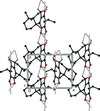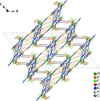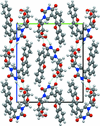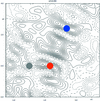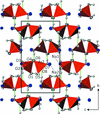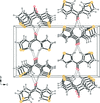issue contents
October 2017 issue

Cover illustration: Carboranylamidinate ligands are a special class of amidinates ions of the general formula [RC(NR')2]- in which the R and R' substituents can be the chemically versatile carboranyl moiety ortho-C2H11B10. The presence of this bulky subsitutent influences the coordination mode of the ligand in metal-amidinate complexes, adopting a specific ![[kappa]](/logos/entities/kappa_rmgif.gif) C,
C,![[kappa]](/logos/entities/kappa_rmgif.gif) N-chelating mode instead of the more common
N-chelating mode instead of the more common ![[kappa]](/logos/entities/kappa_rmgif.gif) N,
N,![[kappa]](/logos/entities/kappa_rmgif.gif) N'-chelating behaviour. Reaction of lithium carboranylamidinates Li[o-(C2H10B10)C(NCy)(NHCy)] and Li[o-(C2H10B10)C(NiPr)(NHiPr)] with SnCl2 and SnCl4, respectively, afforded the two new compounds SnII[o-(C2H10B10)C(NCy)(NHCy)]2 (1) and SnIVCl[o-(C2H10B10)C(NiPr)(NHiPr)][o-(C2H10B10)C(NiPr)2] (2), the latter isolated as a by-product. Compound 2, illustrated here, is the first carboranylamidinate complex containing both mono- and dianionic carboranylamidinate ligands in a single molecule. See: Harmgarth, Liebing, Hillebrand, Busse & Edelmann [Acta Cryst. (2017). E73, 1443-1448].
N'-chelating behaviour. Reaction of lithium carboranylamidinates Li[o-(C2H10B10)C(NCy)(NHCy)] and Li[o-(C2H10B10)C(NiPr)(NHiPr)] with SnCl2 and SnCl4, respectively, afforded the two new compounds SnII[o-(C2H10B10)C(NCy)(NHCy)]2 (1) and SnIVCl[o-(C2H10B10)C(NiPr)(NHiPr)][o-(C2H10B10)C(NiPr)2] (2), the latter isolated as a by-product. Compound 2, illustrated here, is the first carboranylamidinate complex containing both mono- and dianionic carboranylamidinate ligands in a single molecule. See: Harmgarth, Liebing, Hillebrand, Busse & Edelmann [Acta Cryst. (2017). E73, 1443-1448].
research communications




























































































 journal menu
journal menu















